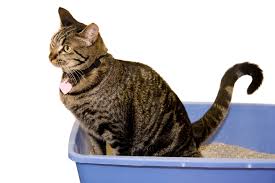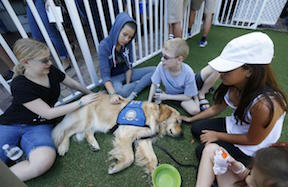A Device That Translates Woofs and Meows Into Words (Not Sci-Fi!)
Dr. Con Slobodchikoff, Pet Translators
 Dr. Con Slobodchikoff (Professor Emeritus NAU) believes we are close to developing a gadget that will translate what your dog or cat is saying into English words. While several novelty items are currently on the market, his work is based in science. Slobodchikoff says, "So many people would dearly love to talk with their dog. With cats, I'm not sure what they'd have to say. A lot of times it might just be, "You idiot, just feed me.'"
Dr. Con Slobodchikoff (Professor Emeritus NAU) believes we are close to developing a gadget that will translate what your dog or cat is saying into English words. While several novelty items are currently on the market, his work is based in science. Slobodchikoff says, "So many people would dearly love to talk with their dog. With cats, I'm not sure what they'd have to say. A lot of times it might just be, "You idiot, just feed me.'"
So how accurate will it be? Dr. Slobodchikoff explains that they're using science to do this and so it should be really accurate. It should tell you what the dog is thinking, what the dog's emotions are like and what the dog wants to do.
This seems kind of far-fetched, because men and women who both speak English have a hard time understanding one another. How is it going to be possible that we really get a grasp of what our animals are saying?
Dr. Slobodchikoff explains that body language is a big component of people understanding what other people are saying. In fact, some studies have shown that in a conversation between two people, 90-percent of the meaning is conveyed by body language and only about 10-percent is conveyed by what they say. So if the man says something like, "I love you" and the body language says something like, "I really hate to be here right now!" What do you think the other person is going to pick up on the, "I love you" or "I really hate to be here right now!" They'll obviously pick up on the, "I hate to be here right now!" Maybe not necessarily consciously, but they'll think that person doesn't mean it when they say, " I love you."
So body language is a really big component of communication of people and it turns out to be a big component in communication of animals as well. What scientists are doing is looking at both the body language of dogs and the vocalizations of dogs and then using artificial intelligence to combine those two to come up with an accurate reading of what the dog is trying to communicate.
Dr. Debbie thinks that this idea sounds fabulous and wonderful, but she's just thinking of all those variables when a dog has something medically going on. Are they going to be able to speak to us and tell us what's wrong? Would they understand what's wrong? Would they be able to describe pain? For instance, could they tell us things like describe my abdomen hurts versus what a person could conceptualize and put it into words?
 Dr. Slobodchikoff explains that there's a very recent study using artificial intelligence to figure out a sheep's pain from their facial expressions. The other thing is that there's a person who has been teaching dogs to communicate by pointing to various parts of their body. This woman has found really remarkable success once she's taught the dogs this kind of pointing language, the dogs can then actually point to areas that hurt. When she then takes them to the vet, the vet confirms that there are problems with the areas that the dog has pointed to.
Dr. Slobodchikoff explains that there's a very recent study using artificial intelligence to figure out a sheep's pain from their facial expressions. The other thing is that there's a person who has been teaching dogs to communicate by pointing to various parts of their body. This woman has found really remarkable success once she's taught the dogs this kind of pointing language, the dogs can then actually point to areas that hurt. When she then takes them to the vet, the vet confirms that there are problems with the areas that the dog has pointed to.
So we know that dogs can actually do that and we know that artificial intelligence can actually read things like pain signals and other kinds of expressions.
So will it be harder to communicate with cats? Dr. Slobodchikoff tells us that cats also have a rich body language and they also have vocalizations. One study found the cats had somewhere over a 120 different kinds of vocalizations. So he thinks that it would be just as feasible to do that with cats. However, do you really want to know what your cat is thinking?
So if they are developing a translator that helps people understand what our dogs are trying to communicate, is there a reverse translator so our dogs can understand what we are trying to communicate to them?
That would be ideal, according to Dr. Slobodchikoff, but that's a slightly harder problem than the one -way sort of thing. However, it may not be as much of a problem as he currently thinks it is, because a lot of dogs actually already understand what you're saying to them. For example, there's a dog named Chaser, who knows upwards of about a 1,000 words in English. There's also a dog named Rico who knows upwards of 300 words in German. So dogs actually know a lot of what we're saying to them but we people are really bad at figuring out what dogs are trying to say to us.
In an age where you have the iPad tablets or the iWatches that you talk into like Dick Tracy, maybe pet translators could really happen in the near future!
Visit Website
How To Achieve Litter Box Success - Dr. Debbie
 It's important to realize not all cases of inappropriate elimination are a "behavior" problem. In confirmed behavioral driven house soiling cases, 20-percent of the cats also had a contributing medical condition at the time. So even if it sounds like a behavioral problem, see your veterinarian to ensure your cat isn't the 1 in 5 that has discomfort, infection, or other health problems influencing her litter box use.
It's important to realize not all cases of inappropriate elimination are a "behavior" problem. In confirmed behavioral driven house soiling cases, 20-percent of the cats also had a contributing medical condition at the time. So even if it sounds like a behavioral problem, see your veterinarian to ensure your cat isn't the 1 in 5 that has discomfort, infection, or other health problems influencing her litter box use.
Drawing Kitty To The "Right" Spot
Check the condition of the box - is it urine stained on the bottom? Throw it out and get a new one. Keep the box clean by scooping twice daily and by performing a complete litter change out twice a week for non-clumping litter or every 2-3 weeks for clumping varieties.
To entice kitty back to the litter box try a litter box attractant like the herbal-based cat litter additive called "Cat Attract."
Multi-cat homes or those with outdoor cats nearby should use pheromone (scent hormone) products to ease social stress and facilitate litter box harmony.
Kitty Eliminates Near, But Not Quite In The Litter Box
Your kitty is telling you that she understands what you want her to do, but something isn't quite right in the litter box environment. First start with providing a larger box, even if this means buying a plastic under bed storage box for this purpose. Look for one sized 18 x 36 inches in size.
Remove any litter box covers. Revisit the traffic flow in the litter box area. Ensure the box is in a quiet, low traffic area. Keep the box unquestionably clean.
Is Your Cat Urinating In Tubs Or Sinks?
Chances are your cat has urinary tract inflammation or infection. The cool surfaces provide relief to the inflammation or discomfort of a medical condition. See your veterinarian for a urine evaluation and treatment since environmental changes alone will not stop the behavior.
To preventing further episodes, decrease access to tubs and sinks, close doors to bathrooms, or fill the bottom of sinks and tubs with a small amount of water.
 Kitty Eliminates On Throw Rugs And Won't Use Litter Box
Kitty Eliminates On Throw Rugs And Won't Use Litter Box
Your cat has already made a litter preference. Perhaps the texture of carpet is more appealing than the litter used. Provide a litter box smorgasbord. This is when you provide multiple litter pans at the same time, each with different litter varieties such as clay, clumping, and natural pine litter. Be sure to include one litter box with sections of throw rugs or carpet remnants lining the bottom. During this time, remove all throw rugs from the house or block kitty's access to those areas.
If kitty demonstrates a litter preference, switch her litter boxes to that style of litter.
If kitty chooses the rug-lined box, then continue providing carpet lined litter boxes to establish a good pattern of repeated box use. Gradually start sprinkling small amounts of cat litter in the box on top of carpet surface. With time, many cats can be retrained to accept the box as the carpet is phased out and just litter remains.
Prevent Returning To Scene Of Crime
Clean all house soiling accident sites with an enzyme based pet cleanser. The enzymes break down the chemical component of the odors, and do more than just cover up with scents. Do not use ammonia based cleansers on accident areas - doing so is counterproductive. (Remember that urine contains ammonia products.)
Cats dislike eating in areas that they eliminate, so place food and water bowls in the site of the accidents, or try placing pieces of aluminum foil in areas to deter kitty's use.
Citrus scents are offensive to cats and can be an effective cat deterrent. Use citrus or potpourri scented air fresheners in the area. If your cat is eliminating in house plants, place lemon or orange peels in the pot to make the area less attractive. And of course, make sure you aren't using citrus scented cleaners on the litter pan!
To keep your kitty away from areas she continues to eliminate on, use double sided sticky tape or turn plastic carpet runners upside down. Another option is to invest in motion-activated devices that spritz out citronella or puffs of air when the electronic eye picks up motion in the off-limits area.
The Tough Reality
For some cats, environmental changes aren't enough and drug therapy may be a necessary tool. But remember that behavioral medications aren't a shortcut - drug therapy must be used with veterinary monitoring and in conjunction with environmental changes.
Want to hear some bad news? In households struggling with many years of feline house soiling, it may be necessary to discard urine marked furniture, change out carpet, carpet pads, and treat sub-flooring to effectively remove scent triggers for future elimination issues. It may sound extreme, but it can be important step to achieve faithful feline litter box success.
Featured veterinarian known as "Dr. Debbie" on national pet radio program, Animal Radio. Ebook author of "Yorkshire Terriers: How to Be Your Dog's Best Friend"; "Pugs: How to Be Your Dog's Best Friend"; "Mini Schnauzers: How to Be Your Dog's Best Friend"; and "Shih Tzu: How to Be Your Dog's Best Friend." Dr. Debbie's books.
Visit Website
 The Dogfather's Grooming Tip with Joey Villani
The Dogfather's Grooming Tip with Joey Villani
Removing Stains From Your Dog
Have you ever been to the Grand Canyon? If you haven't, the Grand Canyon has a lot of red clay. You track it everywhere and stains like crazy. It stains your clothes, your carpet and even your animal.
Not surprisingly, Joey just recently had someone who contacted him after returning from the Grand Canyon. It turns out their white West Highland Terrier brought back some of this staining red clay on their coat. Joey's remedy to dealing with this only works on light colored dogs and will turn a black dog's coat with a reddish tint. But fortunately, this red clay doesn't show up very well on dark colored dogs anyway.

 For Joey's remedy, you take an eighth of a cup of hydrogen peroxide and mix it with a eighth of a cup of corn starch, making a paste. If it's a little too soupy, just add more corn starch because you want something that has a thick consistency, almost a little bit less than the paste you used to use in grammar school. Next, you put this mixture on the areas where the dog is stained. You then let it sit there for a good 20 to 30 minutes. After that, just brush it off and the stain should be gone completely.
For Joey's remedy, you take an eighth of a cup of hydrogen peroxide and mix it with a eighth of a cup of corn starch, making a paste. If it's a little too soupy, just add more corn starch because you want something that has a thick consistency, almost a little bit less than the paste you used to use in grammar school. Next, you put this mixture on the areas where the dog is stained. You then let it sit there for a good 20 to 30 minutes. After that, just brush it off and the stain should be gone completely.
If your dog does decided to lick it, the corn starch is nontoxic and the peroxide is not going to hurt them. However, you could have some intestinal gas issues afterwards.
Joey says to never use baking soda in place of the cornstarch because this can make your dog sick and maybe even irritate their skin, so corn starch actually works better.
Animal Radio News - Lori Brooks
 Pets On Planes
Pets On Planes
Maybe it was better that Dexter the Peacock didn't get on the plane a few weeks ago, because a bulldog named Bator was allowed on a flight in December and was discovered dead in his flight carrier after the plane landed at Newark airport. In another case in September, an American bulldog named Hope on board a United Flight from Santo Domingo was also found dead when his plane landed at Newark. And Rock, a 3-year-old Belgian Malinois who was flown to Newark aboard a flight from Boston last July, was discovered with multiple bruises after escaping from his plastic shipping container during the flight. Last year, 24 animals transported as cargo by U.S. airlines were found to have died in-flight and another 15 were injured, according to a new report by the Department of Transportation. One, a cat named Gage who escaped its kennel at Honolulu International Airport before being loaded aboard an Alaska Airlines flight, was never seen again. The deaths and injuries were only a small percentage of the nearly 507,000 animals transported by 17 airlines. This, of course, comes as an increasing number of pet parents are attempting to take their dogs and cats (and peacocks) on board, claiming them to be service animals. The biggest air carrier at Newark, United Airlines, accounted for most of the deaths and injuries nationwide. The report showed 18 animals died while being transported and another 13 were injured out of 138,178 animals handled nationwide. A spokesman for the company said United saw a significant increase in the number of pets it transported last year, which may have accounted for the rise in transported pet deaths. According to the federal data compiled by the DOT's Aviation Consumer Protection Division, most of the injuries were self-inflicted, caused by an animal's chewing or clawing at their transport crates. However, the Animal Legal Defense Fund has questioned the accuracy of the Federal data, and says people should be skeptical because the Department of Transportation does not require airlines to report deaths or injuries for non-companion animals except for cats and dogs. That means animals being shipped to zoos or research facilities are not reported in the statistics. United sends a 15-page booklet to everyone who plans to ship an animal, which goes over all the rules, crate sizing and pets the airline cannot accommodate. One crate training exercise recommended to owners is to put the pet in its shipping carrier and drive through the car wash a few times, so that the noise, vibration and movement in the plane does not cause alarm. Another option may be to save the money you would use to put your pet on an airplane and instead book a reliable pet sitter. You might even save some money.
 Wet Dog Food Scare
Wet Dog Food Scare
If you feed your dogs wet or canned food manufactured by the J M Smucker Company, usually called Smucker or Smuckers, be aware that the Food and Drug Administration has issued an alert that some of their pet food has been contaminated with pentobarbital, a euthanasia drug. The warning comes after a study found the drug in some samples of Gravy Train canned dog food. Other brands besides Gravy Train that could be affected and are manufactured by Smucker include Kibbles 'N Bits, Ol' Roy and Skippy brands. The FDA says the level of pentobarbital in the foods is low, but the law does not allow for any amount of it in pet foods because it can be fatal.
Dating Advice For Pet Parents
For pet parents, things can get complicated if you are in a relationship that progresses to the point where you are thinking about moving in together. And if the other person is also bringing a pet to the new household then you have a lot to consider. A recent article in Parade Magazine offered some good advice to pet parents who want to combine households had some interesting tips. If you're using dating apps to find a mate, include your pet in your online dating profile so prospects know upfront that your pet is a priority. When you get to the point that you want to introduce him or her to your pet, remember to stay calm because your body language could confuse a fur child with a stranger in their presence, especially if you're on their home turf. Because of that, experts agree your first meet-and-greet should be on neutral ground like at a dog park or other pet friendly location. If that won't work for you, walk your dog out to meet the visitor and then walk back inside your home or apartment together. You may have to do this a few times when your partner visits, but letting your pet dog or cat make this first move to check out the person is critical. Don't force it. In the case of cats, ignoring a cat can work too. Just let your cat make the first move to check out the new human. Another great tip is to have the new human leave behind an article of clothing like a sock or a t-shirt, then give your dog or cat a treat every time they sniff it. Positive association with scent goes a long way.
 Counting Cats
Counting Cats
Because most everyone has their own opinion on whether cats or dogs are smarter, a new study has created quite a stir when it suggested that dogs might have an intelligence edge over cats. On the other hand, a few other studies have shown that cats have a greater mathematical ability than dogs. Meanwhile, other less traditionally "smart" animals like fish and frogs, according to new research, are able to count. In addition, so can chickens and some monkeys, although scientists say research on cats being able to count is unclear at this point. That's mostly due to the fact that cats are difficult to control in a lab environment. So, can cats count? As with most things, the answer might be only if they feel like it. One researcher at the University of Padova in Italy who studies cat cognition says most cats are excluded from research because it's simply easier to work with fish than cats. However, he did a counting study with cats, which was basically the ability to distinguish small quantities from large ones. When the cats did decide to cooperate, they were as good at the mathematical tests as fish, but often the cats just walked away. So now he remains unconvinced that cats can't count and thinks we should keep studying them. Researchers also suspect cats may have an abstract conception of numbers, but it has been suggested that cats may be able to count up to six or seven, though three or four is more likely.
 Jacob The Comfort Dog
Jacob The Comfort Dog
Jacob the Comfort Dog is helping people in the town of Parkland, Florida after that horrific school shooting that killed 17 people. Jacob is a 4-year-old specially trained Golden Retriever. He wears a harness that says, "Please pet me." Jacob is just one of 19 dogs helping the people of Parkland and he's part of a bigger group of 130 Golden Retrievers called K9 Comfort Dogs, which is run by Lutheran Church Charities. They train the dogs to be therapy animals in disaster situations. Unfortunately, Jacob has been building his resume lately. He's already helped survivors of mass shootings in Las Vegas and Orlando. But when they are not supporting people through disaster response, the dogs typically work in libraries, schools, churches, with first responders and at community events. You can follow Jacob on Facebook.
 Listen to the entire Podcast of this show (#952)
Listen to the entire Podcast of this show (#952)





